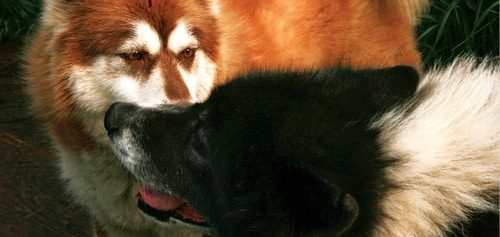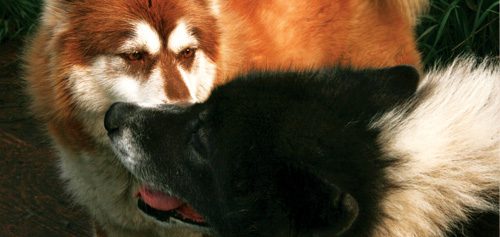

Bark of the Wild
Kings of the Frozen North
When Genevieve Montcombroux was growing up in Paris, she dreamed of living in Canada’s North. Some called it a childhood fantasy, but at the age of 10, Montcombroux knew it would happen the moment she picked up Boreal, a book by French ethnologist and explorer Paul-Emile Victor.
It wasn’t the beauty of the barren landscape that called her. It wasn’t the ancient lives the Inuit lived that intrigued her. It was the broad-shouldered Inuit sled dogs that pawed their way into her imagination. Montcombroux wanted to glide across the frozen tundra, the frigid winds whipping her face as the mighty dogs powered toward the snowy horizon.
She asked her family if she could get one of the northern canines for their Parisian home. “No,” she was told.
Although Montcombroux never did get a sled dog for a pet, her ambition never died and her willingness to dream helped the ancient breed rebound from the brink of extinction.

When Montcombroux grew up and left Paris, her aspiration to keep Inuit dogs never trailed too far behind. She moved to London to improve her English, where she met and married a man named Michael Montcombroux, who became a teacher and had dreams of Canada as well. Michael’s father had traveled on business and the stories he told his son about the country never left his memory.
By the late 1960s, the couple and their two young children decided to move to the country that had long captivated their imaginations. They settled in northern Saskatchewan, but it wasn’t until Montcombroux visited Churchill, Manitoba, that she first looked into the almond-shaped eyes of a Canadian Inuit canine.
“These are the dogs I have dreamed about,” she thought.
It was a monumental moment. Montcombroux was able to touch their stiff and perfectly straight coats that are made up of two parts, a soft undercoat that insulates and outer guard hairs that protect. Because Canadian Inuit dogs were never bred for show, but rather for work ethic and strength, their coats come in a variety of colours—from all-white and pitch-black to steely grey and earthy cinnamon.
For centuries the eerie, guttural howl of the Canadian Inuit dog has been heard across the Arctic. When the ancients traversed the Bering Strait land bridge over 4,000 years ago, it was the dogs that led the way, pulling sleds and carrying supplies. These dogs weren’t—and aren’t—the slender, long-legged Siberian huskies bred for speed that most people associate with sled dogs. Canadian Inuit dogs are the workhorses of the north: bred for power, trained to hunt, and acclimatized to the hostile northern environment.
The Inuit people relied on their dogs for their next meal as much as the canines depended on their human companions for theirs. When a bear or caribou was sighted, the hunter let half his team off harness. The dogs surrounded the bear, frightening it so it couldn’t flee. The dogs kept the animal occupied long enough for the hunter and the rest of the team to catch up and close enough for the hunter to make the kill.
The dogs also sniffed out breathing holes in the ice, where there were bound to be seals rising from the icy water. When a hole in the ice was found, the hunter stopped his team far enough from the hole so they wouldn’t startle the seal, and crawled to the opening in the ice to harpoon their prey. The dogs sat back, knowing a meal was near.

Canines from southern Canada were crossed with Inuit dogs. Many Inuit people stopped hunting and abandoned their teams, but it was the introduction of the snowmobile that caused the canine population in the north to decline rapidly.
Dog power was no competition for these speedy new machines. Before European contact, in the central region of the Arctic and along the east coast, Inuit families kept an average of two to five dogs. Each canine ate as much as a person, and the same food. So the snowmobile was attractive to the Inuit when it first arrived: it was fast and wasn’t fueled by seal meat. But there were downsides.
“With snow machines, they can get to the flow edge in half an hour, unless they get lost,” Montcombroux says. “Well, dogs always come home. The snow machine doesn’t know how to come home, even with a GPS unit, and it can break down.”
William Carpenter, a biologist with the government of the Northwest Territories, says that the Canadian Inuit dog population went from an estimated 20,000 canines in the 1920s to fewer than 200 by the 1970s.
As a witness to their decline, Carpenter felt he had to do something to save Canada’s only remaining purebred indigenous dog. Along with John McGrath, a government economic development officer, Carpenter established the Eskimo Dog Research Foundation in 1974.
“It totally consumed my life, my family, my time, my energies, and all my life resources,” Carpenter says. “I did the work simply because it needed doing.”
By 1976, the breeding program had thirty dogs and a few years later, 250 canines had been given to Inuit wanting to return to their traditional Arctic lifestyle. Other dogs were given to prospecting and mining camps to protect workers from polar bear attacks.
The thick, muscular Inuit dogs are exuberant and friendly, but they have an aggressive side as well. They like to fight. The pack is organized much like that of wolves, with an alpha male, or boss dog, and an alpha female. After that, the dogs take their places in the chain of command.
“And to get their place, they have to fight,” Montcombroux says.
The dogs attack each other’s thick manes, biting the neck and trying to overturn their opponent. The boss dog is normally a combination of the oldest, strongest, and most cunning, and wins the position by defeating the other dogs.
Their combative nature makes the breed unsuitable as house pets, and the fact that they’d rather be outdoors even when it’s -32 F, which is beach weather to these hardy dogs.
“It’s like Florida for them,” Montcombroux says.
By the mid-1980s, Carpenter’s canine program was facing funding difficulties. So Montcombroux got involved. She and Michael were moving south to Winnipeg, Manitoba, and decided to take a pair of dogs to the city with them.
The couple bought 640 acres of forested land north of Winnipeg and, in 1988, they began breeding the dogs. That year, Montcombroux started an organization called Friends of the Inuit Dogs and put out a newsletter to network with breeders and others interested in the unique canines.
In 1997, she met Sue Hamilton, who had brought three Canadian Inuit dogs from the Arctic back to her Connecticut home. Hamilton, along with Montcombroux, formed Inuit Sled Dog International (inuitsleddoginternational.com) and Hamilton became editor of the Fan Hitch journal.
They never saw their involvement as dictating the direction the breed should lead.
“I see my involvement as being a resource for others, a way to put people in touch with each other and a cheerleader of sorts for those in the Arctic who might want to keep traditional working Inuit sled dogs,” Hamilton says.
There are now a number of established breeding programs in the Arctic and Montcombroux feels that the Canadian Inuit dog is no longer in danger of extinction. After 30 litters, with an average of four to eight puppies, Montcombroux feels she has done her job.
“I had felt that although we were in the south and we weren’t Inuit, if we kept the numbers of purebred dogs up, one day the Inuit would become interested again,” she says. “I think the dogs led me on a very interesting path and if I made a difference, all the better, and I just wouldn’t do it any differently.”
Join the newsletter and never miss out on dog content again!
"*" indicates required fields
By clicking the arrow, you agree to our web Terms of Use and Privacy & Cookie Policy. Easy unsubscribe links are provided in every email.

